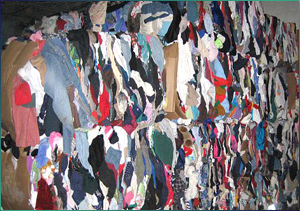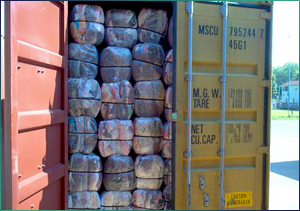
By Tara Raiti
12/10/10
If you had to list three things that can be recycled, you probably wouldn't think to say clothing. But used clothing, also referred to as post-consumer textiles are what recycling companies like Trans-Americas Trading thrive on.
"Ninety-five percent of what we do at Trans-Americas or what we handle is post-consumer textile and that material is clothing that the consumer has deemed has reached the end of its useful life," said Trans-Americas President Eric Stubin.
Trans-Americas Trading, based in Clifton, N.J., purchases, processes, and recycles post-consumer textiles and secondhand clothing. Stubin said his company receives donations from charities and collects textile waste from 20 cities and towns. Here's what his company does with it:
· 30% of the material recycled is sold as wiping products.
· 20% of the material recycled is sold to the fiber market
· 45% is usable clothing which is exported or sold on a wholesale basis
· 5% other, such as remade fashion, where vintage clothing can be redesigned for modern wear

Department stores like Macy's have a few options to get rid of unsold clothing, said, former Macy's employee and current Goodwill store manager, Lori Kluender. Clothing can go to outlet stores, charitable organizations or what is referred to as "RTV," meaning return to vendor. RTV means that the department store will return the leftover clothing that it had purchased from the vendor and agreed to sell.
Department stores must keep track of the length of time the clothing remains on the racks in order to determine when to remove it.
Regardless of the path and order that the clothing may take, Trans-Americas Trading serves as the final alternative for many retailers.
"Everyone tries to make money on the clothing, but a lot of people just throw things away," said Kluender.
"They sell it because there is some recovery value, like a men's suit that was originally sold at a very high end store like Barney's, Bergdorf Goodman, or Saks Fifth Avenue for $1,500 that is still sitting on a rack a year later," said Stubin.
While many clothing retailers have recycling protocols, clothing consumers often do not. They often throw clothing away if they no long use it, creating a serious garbage disposal problem in the United States.
"The problem, the issue of post-consumer textile waste is tremendous. In the United States alone the Federal EPA says that 5 percent of our landfills are made up of post consumer textile waste and 68 pounds per American are discarded annually," said Stubin.
The Environmental Protection Agency cites studies that show up to 4.5 percent of our landfills are still comprised of textile waste.
"The second-hand industry, charities and for profit recycling companies like Trans-Americas recycle 2.5 billion pounds annually. But this only represents about 25 percent of what's out there so we're missing the other 75 percent," said Stubin.
Charitable organizations like Goodwill go through a series of clothing rotations before selling to a recycling company. Goodwill receives 15 clothing racks daily and returns eight clothing racks each time to its warehouse, where the clothing is sorted and either redistributed to Goodwill or sold to a recycling company.
"We run on a four-week rotation scale, meaning if we can't sell the clothing in four-weeks then it goes off to the baling machines and sold to recycling companies who may turn the clothing into rags, for places like automobile companies," said Bill Labelle, logistics director of Goodwill Industries Inc.
The baling machines compress the clothing into giant bricks.

And Trans-Americas Trading takes these bricks of clothing, called "bales" to sell to overseas in developing countries. They are then sold to wholesale importers who distribute it to retail customers in developing countries. Some of the major world markets Trans-Americas sells to include sub-Saharan Africa in places such as, Zambia, Angola, and Tanzania, said Stubin.
"The clothing that you donate, is it brand new and you just don't wear it or are you donating it because it has a hole in it? If it has a hole in it then that's the clothing that is sold to recyclers, who turn the clothes into rags," said Labelle.
"I can deliver a t-shirt for 50 cents a piece to west Africa. We have tremendous economies of scale and we can deliver the only affordable clothing to the majority of the people that's living on less than two dollars a day in these developing countries. People think they know poverty they don't know poverty unless they truly travel to these developing countries. Not on safari not to the capital-seeing vast majority," said Stubin.
Labelle said 30 percent of the clothing Goodwill receives is sold at Goodwill outlet stores, while the remaining 70 percent is sold to recyclers.
So before you toss that old t-shirt you have no more use for that you maybe once cherished, remember that to someone out there, there is still use for it and an entire industry dedicated to discovering it.
It's good to see someone thinking it trhuogh.